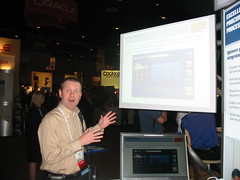
- SAP Community
- Products and Technology
- Additional Blogs by SAP
- ASUG Conference 2008 Education, Networking, and In...
- Subscribe to RSS Feed
- Mark as New
- Mark as Read
- Bookmark
- Subscribe
- Printer Friendly Page
- Report Inappropriate Content
Over 15,000 people are attending the combined ASUG and Sapphire conference this year and the Supplier Relationship Management (SRM) activities were well attended, including pods, village presentations, and education sessions.
Paige Leidig kicked off the SRM activities with a SRM Roadmap presentation. Paige discussed how procurement and sourcing will evolve over the next few years and how the Business Suite, in particular Procurement Excellence, will address the shifting priorities and demands in Procurement and Sourcing. This set the stage for SRM’s contribution to Business Suite Excellence.
The presentation brought a lot of traffic to the pods, where we presented more of the details behind Business Suite Excellence. The pods topics included: Excellence in Procure to Pay, Extensive Source to Contract Processes, Comprehensive Spend Visibility, and Optimized Contract Value. All the pods had constant traffic throughout the day. There was great interest in SRM 7.0. The key learning, as reported by customers, was that SRM will be released with the Business Suite, scheduled for the end of this year, and will deliver:
- ERP and SRM Harmonization – A harmonized user interface and unified purchasing roles, including personalized lists of ERP and SRM business objects together in one screen.
- Service Procurement - Extend sourcing to MM-SRV customers and enhance service procurement via catalog
- Central Contract Management - Centralize contracts across SRM and ERP
- Sourcing Enhancements - Take advantage of SRM RFx capability from ERP
- Technology – A framework and examples for Yahoo Widgets in Procurement processes, such as Manager Approval, Analyze Maverick Spend, and Supplier Information.
Customers and prospects who visited the pods are excited about the new capabilities we demonstrated and are eager to implement the new user interface and widgets. One overwhelming positive impression of the new user interface was the reduced scrolling. As for widgets, people were excited about the widgets as an opportunity to create simple to use, role-based processes that can be accessed from the desktop.
The conference continues to be a good channel for us to meet with customers for SRM usability testing. The SRM User Experience team is testing the new UI design concepts for MDM-Catalog and Service Procurement. The new features being tested include:
MDM-Catalog 2.0:
- MDM-Catalog serves as a central internal catalog for end-users to shop for items and transfer to the SRM Shopping Cart. End-users can compare multiple items and view item details.
- Shopping Lists help users store a collection of favorite items that can be used as a template for future shopping carts.
- While viewing the item lists, end users can switch to different views - Context View (a more visual way of scrolling through the search results) vs. List View
- Related items: this feature is supported by SRM-MDM, and is used to make the user aware of items that might form complementary goods.
- Substitute items: this feature is used to make the user aware of items that are acceptable alternatives to the current item, i.e., similar items
- Accessories: this feature is used as means to up sell products and/or services to customers. I.e., accessories for a camera can be memory card, batteries, etc.
- Item Includes: this feature is used to support Fixed/Configurable Sales Packages or Bill of Materials.
- Service enabled catalog: End-users will be able to shop for service items within the catalog and proceed to purchase these service items via the SRM Shopping Cart.
Service Procurement (SRM 7.0):
- In Strategic Sourcing, professional buyers can manipulate and create a hierarchy structure to handle lists of complex line items.
- End users can organize line items into a logical group, and create Outlines and Headers to support this folder structure. The structure can contain line items of service or material types.
At the conference, I had a chance to see many people from our ASUG Operational Procurement and Sourcing influence councils. Furthermore, I met new people who are interested in joining the SRM influence councils so we should see increased participation in the influence council meetings in the coming weeks. One positive comment from customers about the conference was the opportunity to network with other customers and hear customer success stories. We introduced opportunities into the conference agenda, like the Procurement Forum, to hear from customers and learn from their implementations and best practices. We will continue to create those opportunities outside the conference in the user group influence council session and other events.
Based on feedback that I received, the first day was a good day to learn, network, and influence.
- See you at Google Cloud Next '24 in Technology Blogs by SAP
- SAPinsider 2024: Are You Ready for a Challenge? in Technology Blogs by SAP
- re>≡CAP 2024 | Call for Speakers and Sponsors in Technology Blogs by SAP
- ICPM 2023 Report in Technology Blogs by SAP
- The Reasons to Move to Cloud or Stay On Premise Are the Same - That Makes No Sense To Me in Financial Management Blogs by SAP


